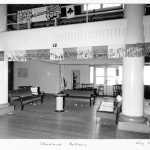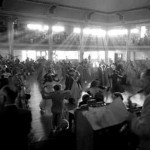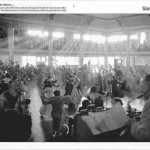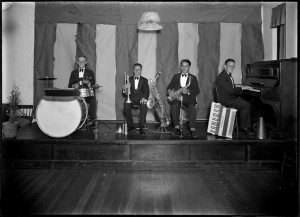The footage at the end is probably a mix of the 1938 gig and a 1950s Newport gig but YOLO BASIE LIVE https://www.youtube.com/watch?v=nYjq1HgnQO4
Category Archives: lindy hop and other dances
Cloudland Ballroom
Ah, Brisbane under Joh. A horrible time for everyone. In 1982 the Deen Bros did as they’d done (and would do) a million times more, they tore down a historic Brisbane building at the government’s instruction, and with dubious legality.
Cloudland Ballroom. Here are a bunch of photos to make you feel sad.
Andrew Dickeson’s Blue Rhythm Band
Andrew Dickeson’s Blue Rhythm Band.
http://bluerhythmband.org/
I wrote this email the afternoon after Jazz with Ramona.
My only regret is that I don’t have any sound files or video to flaunt this band’s mad skills.
Hi everyone,
I had to write to you immediately to tell you about the band we used last night at the Jazz with Ramona weekend: Andrew Dickeson’s Blue Rhythm Band.
I’ve been looking for small to medium sized band that just plays good, solid swing. I’ve been working with Andrew for a while on putting together the right line up, charts, and set structure, he’s done a gig for me with this band before, and played in lots of other bands for, but last night…
I was just amazed.
It was like someone shoved Basie’s band into a four piece. Andrew is gifted drummer and jazz historian (he teaches jazz at the Conservatorium here in Sydney), but more importantly, he really understands what lindy hoppers are looking for in a band. And he has spectacular taste. He not only played great arrangements, be combined the songs inside the set the way a the best DJ would. I was amazed. I just couldn’t believe how good it was. And the musicians play by ear, with some strong leadership and collaboration on who solos when. Andrew invited Mona to tap with him, and it was integrated so well into the band, it was like she was just another musician. It was riveting.
They play classic solid swing. Four on the floor and no cheating – perfect for lindy hopping. Song-wise, they played the things we want. King Porter Stomp. Swinging the blues (the ~150bpm version). Moten Swing. Doodlin’. Jumpin at the Woodside. Jeep is Jumpin’, Flying Home. And they knew how to work the tempos to suit what the dancers could handle, but also to adjust the energy in the room. Playing together, they’d call things like “King Porter’s Stomp, but brighten it up and put some energy in it,” or “Jeep, but go in heavy”. I can’t believe a 4 piece can play a song like Jumpin’ at the Woodside and make it feel like a big band.
Anrdrew’s also very good to work with.
His email: swingishere1234@gmail.com
His phone number: +61 401 354 897
Website: http://bluerhythmband.org/
I cannot recommend this band enough. I have him booked for all three nights of the Little Big Weekend in May, putting together a 4piece, a slightly larger band, and then a 3 piece barrelhouse band. I have absolute confidence in his ability to give each band a different flavour, and to deliver top shelf swinging jazz to my brief.
More importantly, Lennart declared this band very nice and actually went in a jam of his own free will in October. They are that good.
If you book him, I’ll be there.
Breaks
Often instrumental blues used ‘riffs,’ also – single rhythmic phrases repeated over and over, as a background to the melody, or as the melody itself. Jazz today uses riffs. It also uses ‘breaks,’ which come from the blues. At the end of a phrase of melody or words, there is a little pause, during which one or more instruments break away from the melody and make up some fill-in music (pg 20).
This is why I get angry when I watch dancers ‘hit’ all breaks by standing still. If a musician or band leaves you some space, you should fill it. Not every time, but often enough to show you’re listening. This is also why we teach our beginners about break steps in their first or first class. First you set up the rhythm, then you break it. You aren’t just dead weight in this song; you have to bring something to the party, because you are part of the band. When someone calls, you respond.
Teaching and joy
We’re doing some quite interesting classes on our Wednesday nights at the moment. They are all by-request, which means the topics are quite varied. We did a ‘big apple contest’ class open to everyone (most excellent fun), we’re doing a ‘Social dancer’s history of jazz’ class next week (open to everyone again), a ‘steals’ class the week after, and this week we’re doing a class on how to combine 6 and 8 count steps.
I’d ordinarily avoid a class on ‘steals’ because it feels like one of those gimmick classes. But as one of our other teachers said, “If we want to foster those lindy hop traditions like birthday jams, we have to teach them how to steal.” And because our classes are more like structured self-guided learning a lot of the time, it’s the perfect chance for people to experiment with the concept.
The more I thought about it, the more convinced I became. Especially when I thought about it as just another example of how to understand phrasing, and to read another dancer’s body and feels. So while we’ll be looking at how to get into a birthday jam and ‘steal’, we’ll be talking about how to prepare for the beginning of a phrase, how to read a couple’s dancing to see if it’s time to interrupt or not (eg don’t butt in on a big rhythm break), how to ‘cut in’ in a respectful, efficient way, etc etc. And it’s really just a dancing game that teaches us how to partner dance.
The one we’re doing this week is about combining 6 and 8 count moves. More specifically, a follow requested we look at how follows know whether a move is 6 or 8 count. I’m always a bit surprised by these questions, because I simply don’t think about it when I dance. When I lead, I am absolutely not thinking ‘Here is an 8 count move, now I’m doing a 6 count move.’ I just move through space responding to my partner and to the music. If a triple step is nice here, I put it in. If I need to turn or move quickly, I use a triple step. If I’m hitting a break, I might add in a bit of rhythmic flourish. I leave it to the follow to decide whether they need to triple step or kick ball change or step or kick or whatever. This isn’t 2003: I don’t micro-lead. As if I ever did.
But then I thought about what I do when I’m following. Again, I don’t think ‘6’ or ‘8’ as I’m moving through steps. But what I do do, is use the steps that get me through the shapes most efficiently (or most pleasingly). So I might use a triple step to move quickly through a turn (I rarely spin), I might use a kick/bounce combination to get through a pivot. And so on. Again, I use what gets me through the space I need to cover. I’m moving through the music (ie through time) at the rate my partner asks. And a 6 count move is just moving through a shape 2 beats faster than in an 8 count.
What it made me realise was that perhaps we’d over-emphasised the ‘basic rhythm’ as an 8 count. Perhaps we’d given the impression that an ‘8 count move’ has to be a particular rhythm. When we all know that a move can be any count, and we regularly use 2, 4, 6, 8, and 10 count steps in our lindy hop. So there may be a couple of issues here that we need to address.
First, that the steps you dance (ie the rhythm ‘blocks’ – triple steps, steps, etc) are really whatever gets you through the shape most efficiently (or pleasingly). As a follow, your lead begins the move, suggesting a speed at which to move through the move. Because the connection is a two-way thing, the lead can ‘ask’ you to maintain that particular speed throughout the move, particularly if they hear something in the music and have something planned. But a good lead is listening to the follow, and a good following listening to the lead, so you’re paying attention to the connection. And if the lead asks you to maintain that initial speed and direction (or intensity!) it’s nice to do that. Because lindy hop is a partnership. But as a follow, you get to finish the move, and if that means you take 2 more counts than they’d suggested, that’s ok. So long as you keep to the ‘spirit’ of the move, or the vibe the lead is setting down.
[NB Ramona talked about this in classes the other week: the lead begins the move, the follow finishes it. So leads need to let follows finish the move.]
[Other NB I’m beginning to be convinced that leading and following are very different things. It’s not just the same issues of biomechanics applied differently. Leads have a different timing to follows; leads are closer to the beat, a little ahead, the follows a little behind. So to me, the lead is the cab of a semi trailer, and the follow the long trailer. So as a lead, you need to account for that delay when you lead – the follow will get there a tiny bit later than you. I’ve also discovered that it’s this that I find really, really difficult to change when I swap between roles. I’m beginning to think I need to specialise in just one role to really improve. And you have to be as good as Ramona to do both really well.]
I think this is where the real problem comes for a lot of our follows who go social dancing with leads who work in other paradigms. Those leads think ‘ok, I’m doing move X’ and then they set it in motion, but are already thinking about or moving on to the next move before the follow has completed the first move. They don’t allow for the follow’s slight delay in addition to the ‘time’ it’ll take to do the move. In other words, they can’t think beyond their own experience of time during a song.
This means that you get a lot of leads who rush follows through (for example), the final triple step of a swing out, so the follow starts rushing in on 1, instead of really using that last triple step to get momentum into their body. Even more upsettingly, you get a swing out that stops and starts in hard breaks at 8 and 1. And of course the ‘swing’ falls out completely, as everyone rushes rushes rushes to get through the move.
Secondly, the rhythm blocks you use are both functional and creative. So a triple step is great for moving through space quickly (eg on the turn of a swing out), but also wonderful because it’s a syncopated, swinging rhythm that works so nicely with swinging jazz. It’s not like a cha-cha-cha rhythm. Triiii ple-step. Or tri-PLE-step. Varying the accent on a triple step is super fun, and understanding the difference between a triple step and step-stomp-off is also super fun.
Thirdly, this ‘8 count’ structure is something dancers enforce on the 4/4 timing of jazz. The musicians don’t think in 8s. The 2, 4, 6, 8 is a structure that we either build into the song, or we force on top of it. I think it’s better to build it in. So we listen to the music, and find ways to emphasise what’s going on in the song, using our different rhythm blocks, combined over particular lengths of time. And we use even numbers/counts because that’s where the emphasis is in swing. I prefer to think about a song as one long series of beats in time. Some of the beats are emphasised. Some groups of beats are emphasised. Some musicians only play some of the beats. And so on.
So the most important part of dancing is that you carry that consistent beat within your body all the time. All your movements must come from this, both in a creative sense, but also in terms of biomechanics. You use the ‘bounce’ or engagement of core muscles to make a pivoting kick work. You use the ‘groove’ to connect with your partner and the music.
Anyhoo, because I find it so difficult to understand why people have trouble distinguishing between 6 and 8 (or want to distinguish), I’m really looking forward to the session. We have some fun exercises set up, and that group has lots of opinions, so I’m really keen to learning more about how they’re thinking about music.
Teaching. Could anything be better? No.
Not all ballrooms…
more about safety
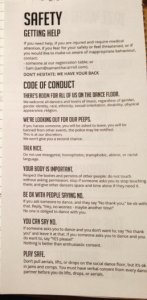 I’ve been fussing over what to put on a paper version of our code of conduct to have at all our classes and parties. Until I realised I could just use the ‘back’ of the Jazz with Ramona program I developed.
I’ve been fussing over what to put on a paper version of our code of conduct to have at all our classes and parties. Until I realised I could just use the ‘back’ of the Jazz with Ramona program I developed.
SORTED.
When I get more time I’ll break up the text a bit or add some amusing line drawings or something.
btw, I’m fine with people using the content from this document.
BUT it is far more important to develop your own, so:
- It reflects the culture of your organisation,
- You actually understand and really believe everything in the document (ie haven’t just cut and pasted something out of obligation).
- It works well as part of your broader safety strategies – how does it relate to your online policy document/page? Do all your staff understand it, and have they been trained in (and know how to) apply it? Do YOU know how to use it when you have to actually ban/warn/press charges against offenders?
It’s a gloriously light-touch way of teaching
This is the most important thing I’ve learnt about teaching dance:
As Jane Williams-Siegfredsen, the author of a book on Danish forest kindergartens, puts it: “There’s this thing where the pedagogue needs to stand back sometimes and not always jump in and help the child. They need to let the child overcome problems themselves. We learn so much more from doing that.” (Kids Gone Wild 23 Feb 2016)
I really enjoy this approach to teaching. You give the students a task (use your rhythm to move around the room), and then you let them do it. You don’t interrupt them to ‘fix’ things, you just let them do it, and fix it themselves. They learn so much from this approach.
After you do the exercise, you get together in the group and say “Ok, what did you observe? What was hard? Easy?” You take questions, and you tell them things you saw that you really liked. “I liked the way X and Y stopped and grooved on the spot a bit when they got out of time. I didn’t get run into once, because you’re all being very safe and keeping your feet under your body – I loved that.” And when they ask questions (they will), they say things like, “How do you know when the lead is going to start moving?” and then you add more info about how to be in closed position and how to give and receive information through your body to your partner. After you give that new information, they must dance on it immediately. And you must only say one thing – to the leads, and to the follows.
It’s a gloriously light-touch way of teaching, and I adore it. You don’t see ‘perfect’ dancing right away, but you see people learn to communicate, to lead and follow, and to social dance to music. Most importantly, they keep their own individual style and you can see their personalities come out. It’s also nice because it teaches them to see difficult stuff not as a ‘problem’ or ‘getting it wrong’, but something to figure out and explore with a partner. To me, this is most excellent learning and teaching: you’re helping people figure out that they have the skills they need to learn, and you’re with them as they get started on the lovely long process of dancing.
Fucking harden up, blokes, and get your shit together.
A very nice male friend posted this on facebook tonight:
It occurs to me that I have never ever had to consider the fact that at some point in my life I may be raped. It’s just so improbable that it would ever happen to me that it’s not worth considering.
The fact that around half the planet are confronted with that very real possibility blows my fucking mind.
I commented there (though I should have just gone straight here to my blog):
I sometimes think the only possible response is deep, dark depression, crippling anxiety, or manslaughter. I remember reading in Adam Gussow’s book ‘Seems like murder here’ a story about the song Crazy Blues. In the south, lynching and violence were so common, black lives so curtailed and repressed, that ‘going crazy’ was sometimes the only response – a young man or women would ‘go crazy’ and talk back, hit back to a white assailant, triggering a horrific violence for themselves and family. Because they just couldn’t stand it any more.
When I think about the awful shit that that men do to women and children every single day, I get so angry. I get so angry I can’t even move. Because if I didn’t get that angry, I’d fall into a pit of depression and never get out.
I think that this is the truly unbelievable thing: that women deal with the constant threat of violence, the constant sexual harassment and bullying, the absolute curtailment of our careers, our physical liberty, our creative lives, and we just continue on. When you think of this, eating disorders and self-harm seem the only real way to gain control of your own body and life. The other amazing thing is that women don’t end up hating men. But of course we don’t, we’re trained to blame ourselves and hate ourselves instead. So maybe it’s even more amazing that feminists don’t just hate all men.
This is why men don’t need more male role models to improve their behaviour. They need to look at the women who do get up every day and go to work or become leaders or raise families, and think “I want to be like her, because she did all this despite the daily threat of rape and violence.” They need to look at women in our lindy hop scene, and think, ‘Holy fuck. She’s standing up there on stage DJing, singing, judging, teaching, organising, drawing attention and making herself visible, and she knows there are men out there in the crowd who are thinking about raping her, and she does it anyway, because fuck. A life lived in fear is a fucking waste and fuck that shit.’
Me, especially now I’m older, I’m both burning with rage, and also deeply patient and prepared to do most anything to fix shit. This is why I don’t give second chances to sexual harassers in my lindy hop scene, this is why I call out fuckwit men who make sexist jokes, this is why I am prepared to stand up and call BULLSHIT on event organisers who don’t have sexual harassment policies and don’t hire women DJs, this is why I have no fucking patience for whingey arse men who sook about not getting their own way in the lindy hop world. Compared to the way I worry about my own safety every day in my own home, some arsehole man giving me shit on the internet is nothing. NOTHING. I’m here to make things harder for them, and easier for women. Straight up: I am a pain in the patriarchy’s arse. Because I am so fucking done with this shit.
What I don’t understand is how a man can like a woman (any woman!) just even a little bit, and not step up and do whatever he can to make her life better for her. Why don’t men tell men around them to quit groping women, to stop the stupid sexist jokes? If I can do this, with that fear of violence, how fucking slack are the men in our world, that they can’t overcome the inertia of their own privilege to speak up for me and for other women and girls? What the actual fuck are they doing with their time?
I’m still really angry and disappointed in my male friends that I have to confront a man to tell him to stop groping women. I have to risk him threatening me in public. I have to risk him coming after me when I’m alone. I have to choose to look over my shoulder at dance events forever. When the men who would be risking so much less won’t even come and stand next to me when I confront him because they are ‘too scared’!
One of the things I’ve learnt about stepping up is that I’m actually fucking brave and fucking fierce. Sure, I’m more visible, and I may be increasing my risks. I sure as fuck risk my professional reputation, because stepping up actually loses me teaching and DJing gigs. But FUCK it. I’m really tired of being careful. I’ve decided to be a pain in the arse. Because yolo. I’m a middle class white woman, and I have a degree of power. It’s my responsibility to use it. And it makes me fucking strong, and fucking fierce. I have to remember that the next time a scary guy tries to touch me on the train. I can fuck his shit up if I need to.
It’s at moments like this that I get far, far angrier at the men I know who don’t assault women, but are also NOT taking half the risks women take every day, to stand up, and get fucking useful. Wearing a stupid white ribbon on your shirt doesn’t make a man a useful ally against violence. Standing up and getting in the way makes a man a useful ally. Speaking up and interrupting yet another sexist joke makes a man an ally. Learning to follow makes a man an ally. Shutting up and letting a woman speak makes a man an ally.
Jesus christ. It’s not that hard. Fucking harden up, blokes, and get your shit together.
Women MCs
Is it different for women? – Lucinda Holdforth (2/23/2016)
I’ve been thinking about the role of MCs in the dance world, lately, and why so few of the best known (and paid) MCs are women. Basically, the reason is SEXISM on the part of organisers. If you haven’t hired a woman MC, you’re buying into patriarchy. That’s just the deal. Excuses like ‘He’s just so funny’ or ‘People know him’ or ‘I just can’t find any women MCs’ will NOT fly. Teaching at an international level requires good speaking skills, so if you’re hiring a woman teacher, you’ve got the beginnings of good women MCs.
This is my favourite bit of this article (of course):
Know that the rules are there, and that they are stupid. And chuck them. Overcome them. Overturn them. If we all stopped playing by the rules, then the rules would quickly crumble. Make your jokes, admit your weaknesses, boast about your accomplishments, wear whatever-the-hell you like, don’t give a damn about a few extra kilos, take up a lot of space, and generally act like you own the joint.




